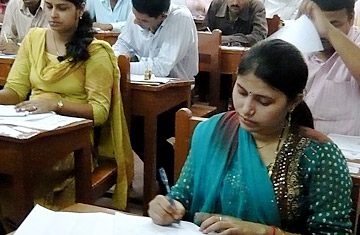
Students of Nalanda Open University in the Indian city of Patna take a test at the end of a semester
(2 of 2)
Although experts often question the quality of the country's open universities, they may be one of India's best hopes for reaching its goals. The schools educate more than 15% of India's higher-education students, most of whom are poor and from rural areas.
India's open universities tend to offer practical training in computers and agriculture or preparation for the country's civil-service examination, which can lead to a stable government job. But IGNOU has also expanded its offerings to advanced degrees in technology and engineering, along with liberal-arts subjects like French and women's studies.
Rajesh Kumar, 26, is from a small agricultural town in Bihar. He works part-time doing data entry and in his free time he takes education courses through Nalanda Open University, which is based in Patna, the capital of Bihar.
"I wanted to get a teaching qualification," he said. "Here, it's easier." Unlike India's competitive public universities, open universities accept all applicants, and they're cheaper than private institutions. A year of tuition for a bachelor's in education at Nalanda is around $37. In an effort to boost the number of female graduates, women only have to pay $27 a year.
On a humid summer day, Kumar stood among hundreds of other students at Nalanda's cramped headquarters in the city's sole high-rise building, waiting to complete an end-of-course exam. Taking an open-university course is generally a lonely endeavor, however. For computer and science classes, students must attend labs, and they can contact faculty at one of the university's 32 study centers around the state if they are struggling. But for most courses, students study texts printed and mailed to them at home.
India's open universities are increasingly piloting new methods and materials, however, such as online wikis, where students and teachers can share material and digital libraries. IGNOU makes its content available free on the Web so students can learn without paying fees, and faculty at other schools can borrow ideas or replicate entire courses. IGNOU is also experimenting with brick-and-mortar classes, so that students can benefit from interacting with professors and classmates.
Outpacing the U.S. in the number of students enrolled will mean nothing if they don't finish or graduate underprepared, however. IGNOU doesn't track dropouts, and experts worry about the quality and the outcomes of distance-education programs in which students who lag behind may receive less support than at traditional schools. "In some places they're doing a wonderful job where the traditional schools cannot be set up," said Pawan Agarwal, an adviser on India's Higher Education Planning Commission. Nevertheless, "they've expanded very fast and there could be some concerns."
Open-university administrators are aware of the doubts and reservations some may have. "Quality is one of the major focal points," Ramanujam, of IGNOU, said. But, he added, the country's open universities are "gradually getting more acceptance and more prestige."
This story was produced by The Hechinger Report, a nonprofit, nonpartisan education-news outlet affiliated with Teachers College, Columbia University.
